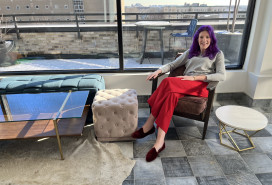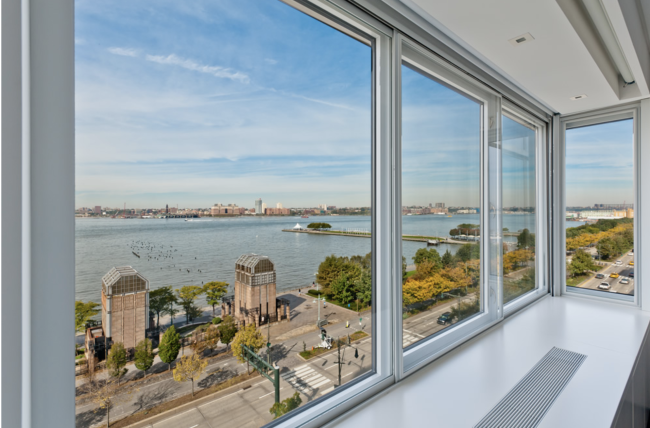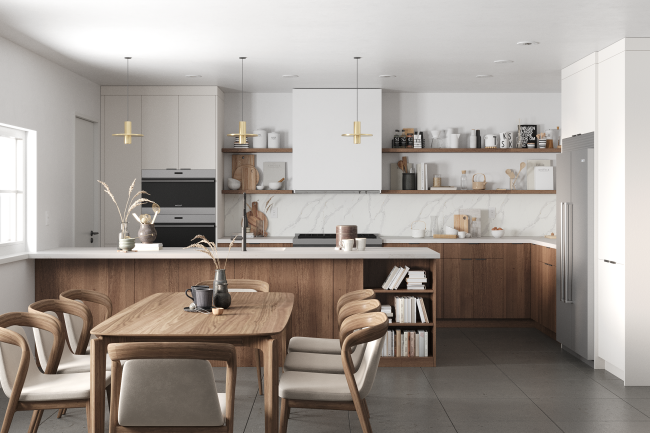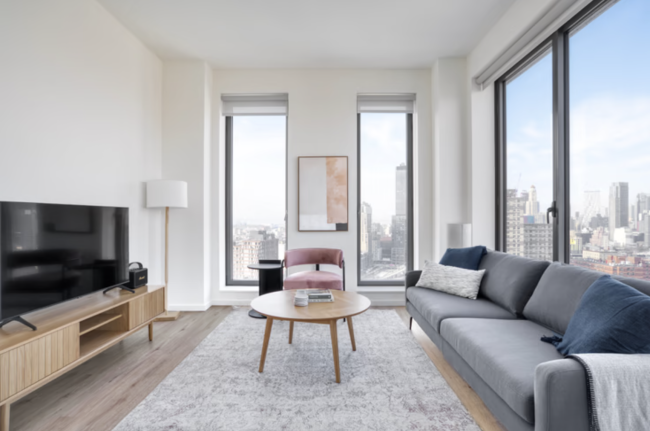Everything you need to know about combining apartments in NYC
- Combination apartments make sense when listings are scarce and prices remain high—as they are now
- Boards (especially in co-ops) can be strict about renovations, so do your due diligence before closing
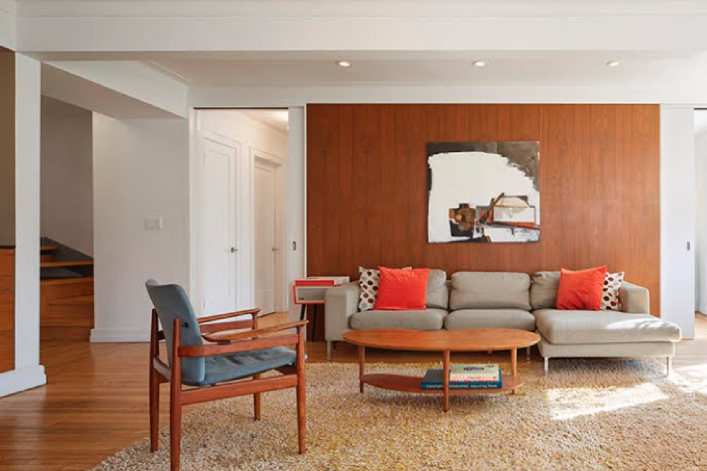
This apartment on Grand Army Plaza in Brooklyn was first expanded horizontally (the original common wall came down at the beam) and then vertically, with a staircase combining the two units.
Design by LOCAL Brooklyn (now Lenzlinger Architecture). Photo by Ben Rahn, A-Frame Studio
Thinking of combining two apartments to create your New York City dream dwelling that offers the space you need? This may seem like a good solution for buyers and current owners—especially if you’ve outgrown your apartment and are unable to find anything more suitable.
Combination apartments make sense when listings are scarce, as they are now, notes Jonathan Miller, CEO and president of the appraisal firm Miller Samuel, in his blog.
"It may be easier and/or less expensive to buy the apartment next door to create a bigger space —even if you have to overpay for it—than to brave the tough market searching for a larger place to live," he writes.
“The easiest combinations involve adding a small apartment to a big apartment, so that what you’re really creating is a master suite,” says David Ackerman, whose renovation company Urban Standard has combined co-ops and condos across Manhattan and Brooklyn. “The hardest and typically most expensive is combining similar sized apartments, because then you need to completely reimagine living and sleeping spaces.”
You can shorten some of this process by checking whether similar units have been combined in the building: “Assuming you like the layout, you’ll also get some assurance that the board will approve your combination,” Ackerman notes. Have questions about combining apartments? Schedule a complimentary on-site visit or telephone consultation with the experts at Urban Standard. >>
It's true: More often than not, buyers resort to combining units after they’ve searched unsuccessfully for a larger apartment. Adam Meshberg, founder of architecture and interior design firm Meshberg Group, says he has done numerous vertical and horizontal combinations (mostly the latter) for clients who simply gave up on ever finding a three- or four-bedroom apartment that suited their needs or budget.
“There just isn’t the inventory, even in newer developments,” he says.
[Editor's note: A previous version of this article was published in June 2022. We are presenting it again as part of our winter Best of Brick week.]
Doing a combination, however, is not for the faint of heart—you're in for a long, bumpy journey. Boards (especially in co-ops) can be strict about what work they will allow, so you’ll need to do your due diligence before closing. And once you present plans to a co-op board, that does not mean you are instantly approved.
Another warning: You could end up with an awkward layout. Some apartments align beautifully, others not so much, so involving an architect early on is imperative in terms of knowing what that combination will look like and what it will cost.
Brick Underground spoke to brokers, architects, mortgage experts, and real estate attorneys to glean the best practices for combining apartments in NYC—and how the process differs in a co-op vs. a condo
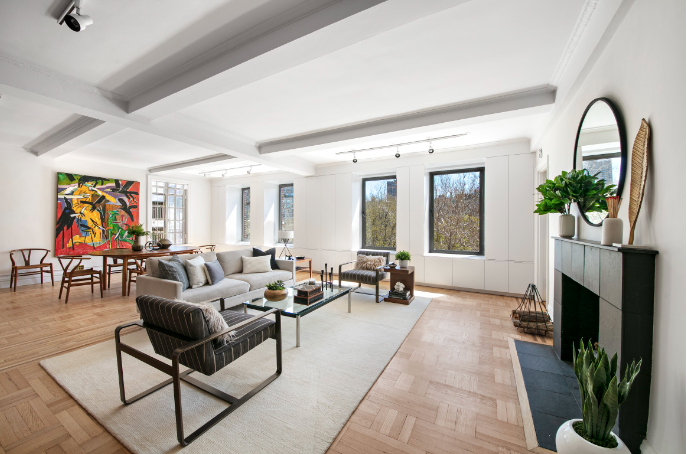
How is combining two units better than buying one large one?
Some sellers package two units as a combination opportunity, which may allow you to get into a desirable building that doesn’t otherwise have big-enough spaces.
Lindsay Barton Barrett, a broker at Douglas Elliman, says there have been plenty of combinations at 10 Park Ave. in Murray Hill, which used to be a hotel with mostly studios and one bedrooms.
Don't be afraid of co-ops in NYC
"Co-ops are generally 10% less expensive than condos. Their rules are designed to protect the value of your apartment and ensure your neighbors are financially sound," says Matthew Steer of SteerKelly Team at Keller Williams. "As your broker, it's our job to make sure you qualify for the building you're interested in. We have a 99.9% success rate of getting buyers board-approved." Get in touch with us >>
“Sometimes you have to gut renovate both units but it’s nice when you can follow the lead of a renovated larger unit and carry that over to the smaller one, or you can look to other examples in the same building or line for inspiration,” she says.
Allison Chiaramonte, an agent at Compass, says it may be easier for you to purchase two smaller units—say, a studio and one bedroom—than to purchase a two bedroom at a higher price point.
“A combination purchase in a condo can also represent a unique opportunity when you might not otherwise be able to pass a co-op board’s liquidity requirements or more generally because pricing based on square feet usually increases with unit size,” she says.
Purchasing two units and combining them often means a discount on the price in recognition that the buyer will have to file plans, obtain board approval, and carry the apartment for several months while the combination takes place, says Nadia Bartolucci, a broker at Douglas Elliman.
What’s more, you can end up with more space and/or the ability to configure a unique layout that could be more desirable.
“We’ve been working on a lot of apartment combinations, both horizontally and vertically, because buying two apartments and combining them is often more economical than buying a larger apartment,” says Yaiza Armbruster, founder of architecture and interior design firm Atelier Armbruster.
What are the benefits of buying a second place where you already own?
Barton Barrett says combinations are a way for people who need more space to keep living in an apartment and building they know and love.
You may not even be thinking about it until your neighbor knocks on your door to see if you’re interested in buying—Barton Barrett says any smart seller would do just that. (Sellers, take note.)
Staying put is also more convenient. You won’t have to sell your apartment or move out and find a new one, which can take months or even years. You can also save on significant sale transaction costs and put those into the renovation instead, Barton Barrett suggests.
Then there’s the difficulty of navigating the buy-sell journey in NYC. Unless you have the financing to secure your new (larger, pricier) space before you can sell your existing apartment (or the nerves and luck to do both deals simultaneously), your options can be pretty limited. Buying a (smaller, cheaper) neighboring unit can be a lot more financially viable, Barton Barrett says. And you’ll save on capital gains taxes on an apartment that you’ve been in for years.
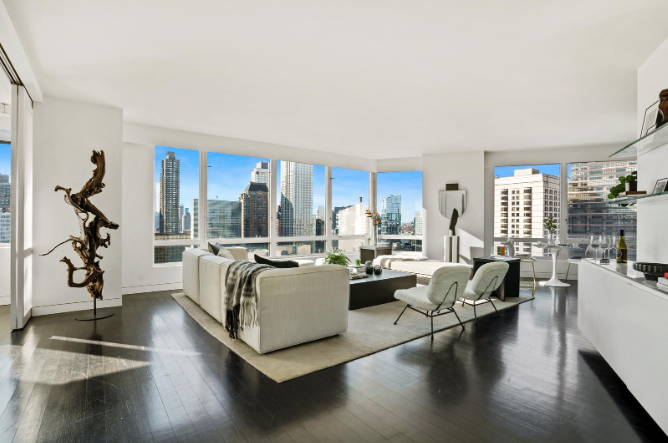
Are there reasons not to expand in your current building?
Be sure to consider the downsides of combination apartments, especially if it means you will be owning the largest unit in the building, Barton Barrett advises. For example: Is it going to trade for the same price per square foot and appreciate at the same rate as an apartment would in a bigger building? (More on checking comps in a moment.)
Being the majority shareholder in a small co-op building (like one of her clients, who is thinking of combining for 60 percent rights) can be frustrating because you won’t have control over what you can do. If this is an issue for you, Barton Barrett suggests buying a townhouse where you are the sole owner and then renting out a unit. “It’s a smarter investment,” she says. Or take that money and buy in a big building.
Dean Roberts, a real estate attorney at Norris McLaughlin who works with co-op and condo boards, also cautions buyers to think long and hard about getting themselves into this “prickly situation” where you have to rely on your neighbors to get anything done. “Even if you have 51 percent of the voting rights, you’ll have absolute power but with that comes a lot of hostility and problems.”
Chiaramonte advises considering whether the combined apartment will appeal to subsequent buyers in your market—maybe it’s sprawling but has an unappealing layout or undersized kitchen. She often sees combinations that are large but have wasted square footage because there is no logical combination of rooms and/or have monthly carrying costs that are too high.
If you have recently renovated your existing apartment—or are purchasing two apartments and paying for their individual upgrades—it is not always a given that you can pair them seamlessly without additional costs, she adds.
In other words, just because you can combine doesn’t mean you should. For example, Miller finds that layouts tend to work better in prewar and new developments than in post-war condos, which often have the least combinable layouts. "Over the last decade, developers have kept this in mind during construction to give them more flexibility during the sales process," he writes.
The brokers here recommend pulling comps of apartments that match the size of your combination. If yours will be priced the same or higher (based on your broker’s estimate) but does not have a logical layout, think again about going through with the combination.
Visiting open houses is another great way to get a feel for whether or not your combination will match what’s available. (Read here for other tips from former owners who combined apartments.)
Finally, even if the layout makes sense, the combined maintenance fees might be prohibitive. Do the math
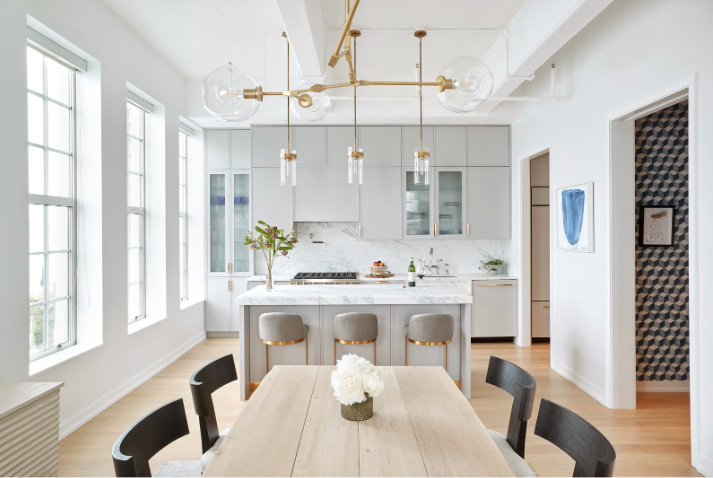
Do co-op and condo boards usually approve combination requests?
Erica Buckley, an attorney who heads the condo and co-op practice at Nixon Peabody, says unit combinations have become pretty standard and well-run buildings tend to have detailed documents that provide mechanisms for buyers to do them. Even still, buildings will consider it on a case-by-case basis, and it can depend on the total number of units in the building.
With a condo, you need to look at the approval process set forth in the condominium documents. It may be something you can do as a matter of right or you may need consent from the condo board, “which is not unreasonable since an appropriately done combination would require an amendment to the condo declaration,” Buckley says.
In a co-op you should first look to the alteration agreement to see when and if combinations are permissible.
In Roberts' experience, once the boards understand the process of combining apartments, they get much more comfortable with it. “So long as it is explained to them clearly and it doesn’t involve major architectural misadventures, like busting out structural walls and re-routing building systems, it is much easier to get done,” he says.
You can also take the stance that your investment in the property is a win-win for the building. Barton Barrett says many buildings now tout the number of combinations as being a clear indication of how much people love the building and never want to leave it.
“There’s a certain cache of having larger units and the average unit size will go up, so I haven’t run into resistance for combinations beyond the generalized resistance to renovations overall,” she says.
In the case of major pushback, Roberts suggests being prepared to show proof of your ability to foot the bill for the purchase as well as the construction and carrying costs of the combined apartments. That financial viability can speak louder than words.
What DOB rules do you need to be aware of?
Whenever you are combining two or more apartments, there are a few important guidelines from the Department of Buildings that you should be aware of in terms of the types of permits needed and the final approval.
Not all combinations, for example, require a change in the Certificate of Occupancy (or C of O) so long as they meet certain requirements, for example, the work doesn’t change the number of bedrooms or the primary means of egress (e.g. entrance doors) in a duplex.
You must also break through the common wall with at least a door (or interior stair for a duplex) and remove the additional kitchen, though you can keep the plumbing for a bathroom or laundry room in place.
The DOB reviews your plans just as it does for any apartment renovation and issues permits and conducts inspections accordingly.
Upon final sign-off, the DOB will issue a letter of completion (or require you to obtain a new C of O if you end up not meeting the stated requirements).
What is the typical timeline for combining apartments?
In condos you usually have much more leeway to sit on two units—and even rent out the extra one—before you actually combine them. (But that depends on the financing, discussed below.) That’s why you can sometimes find two adjacent units in a condo for sale by the same owner.
It’s an entirely different story with co-ops. Most likely you will need to submit your architect’s plans and drawings to the board for approval and agree to a specified time in which you must obtain DOB permits and initiate construction. “This is important if you were hoping to put off the combination for a while, as that might not be an option in co-ops with strict primary residency requirements,” Buckley says.
Roberts says that co-op boards will usually require you to sign an agreement saying you will combine the units in a certain time or face a penalty. “The [co-op] board doesn’t want two apartments owned separately, the concern being if they are not combined legally they will be combined illegally.”
In buildings that do allow combinations, they may only allow one renovation per year, so you may be put on a waiting list. Generally speaking, it is easier to navigate the approval process if you have an existing relationship and are already living in the building, Chiaramonte says (although there’s still no guarantee).
You must also be mindful of the hours in which you’re permitted to do construction, usually only during workdays. Some buildings (usually stricter co-ops) also have summer work rules. This means that one can only work on the apartments between Memorial Day and Labor Day.
“This is an important point because depending on how extensive the scope of work is, one could be carrying the apartments"—in other words, paying for the mortgage and maintenance/common charges for them—"for a while before even setting foot in them,” says Rachel Altschuler, an agent at Douglas Elliman.
Is there more paperwork to combine apartments in a co-op or condo?
Many experts say the paperwork for combining units makes them harder to do in a condo than in a co-op.
That’s because in a co-op you are just issued more shares, but in a condo you have to change the declaration and also file for a new tax lot with the Department of Finance before you file for a permit with the Department of Buildings.
There is one caveat per Buckley: “A lot of co-ops do not want people to get around the primary residence restriction by saying they are going to combine two units but never actually do.” Be prepared to agree to combining within a specified time frame.
In both co-ops and condos (but more likely in a condo), you would have to see if the sponsor is still involved. “If so the question is: ‘Does the sponsor have any approval rights for any remaining period of time,’” Buckley says.
What should you know about expanding into a building's common space?
Acquiring common space, usually the hallway connecting the two units, is “very common” in co-ops where it’s just a matter of issuing more shares, Buckley says. (So long as there are enough of those, Roberts counters.)
According to Miller, the co-op wins by getting a cash infusion for the purchase and income in perpetuity for the additional share allocation from the common area purchase.
It’s a little trickier in a condo, where the allocation of common interests set forth in the condominium declaration are meant to be permanent. What usually happens is the condo will license the common area to you “and not everyone is comfortable with that because it could be revoked down the line,” Buckley says. There are always exceptions to the rule (such as in a sponsor situation), where you could purchase the extra square footage, but that’s not a done deal.
Meshberg has had combinations where common space was part of the plan, including a recent client who bought the corner apartment opposite his so they could capture that hallway space. “It’s a great way to get more square footage," he says.
Barrett once marketed a combination that involved 45 square feet of hallway space. “It made the combination and it’s something the condo had indicated being amenable to because everybody wins in that situation.”
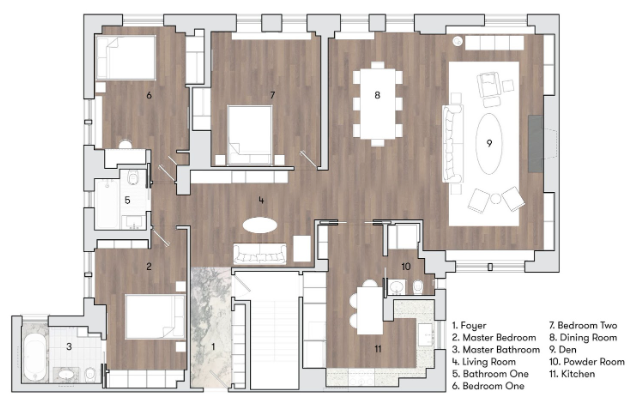
What do architects consider when combining apartments?
"We start by reviewing the building’s alteration agreement, which tells us if the building has specific rules like summer construction rules (when work is limited to between Memorial Day and Labor Day) or 'wet over wet' rules, that only allow you to keep wet areas like kitchen and bathrooms above wet areas in the floor below," Armbruster explains. In her experience, because prewar buildings have very small bathrooms and kitchens, some prewar co-ops allow increasing the wet areas by 10 percent. Both prewar and post-war condos often have more relaxed rules.
Meret Lenzlinger, founder of architecture and interior design firm Lenzlinger Architecture (formerly LOCAL Brooklyn), says the main concern is to make sure that the place where you would connect the units is neither structural nor a building chase wall—otherwise you may end up not being able to remove that wall to open up the space or put the door where you want it to be.
Meshberg points out that a newer building with concrete columns is going to be easier to assess than an older prewar with load-bearing walls. There are also transitions to consider, such as different floor and ceiling heights.
He adds not being able to move any common elements like plumbing stacks behind the walls as another obstacle. “You can design an awesome floor plan but if the toilet is now 25 feet from where it was before, it won’t work," he says.
That’s where hiring an architect to do a pre-purchase walk-through and study the floor plans can save you much heartache down the road. Your architect will also look at any other combinations in the building and especially in the same apartment lines and also talk to your building’s super, who will be the most knowledgeable. “Those are the people I go to first,” Meshberg says.
For example, the super would be able to tell you if the old kitchen has been walled off and there are gas risers there that can’t be moved (true story that some owners had to learn the hard way).
Armbruster says a high percentage of her clients bring her on board before buying real estate "to review possibilities and their wishlist with us."
Meshberg will sometimes charge $2,500 for an initial assessment and sketches, other times he just factors that into the overall job when it’s on the higher end.
What are the differences between vertical vs. horizontal apartment combinations?
Duplexing up or down might prove more difficult simply because you’ll have to build a new staircase, which means structural work by definition, Lenzlinger says. This might possibly give a co-op board pause and will also be more expensive than removing a non-load-bearing wall or putting a door in between units.
But Meshberg says you can sometimes have more flexibility with vertical combinations, at least on the upper floor because you can actually move a bathroom on the top floor and access the plumbing from the ceiling below (assuming it doesn’t violate any wet over dry rules).
What are the potential renovation costs?
If you keep everything as is and just put a door in between, your main cost will be filing for permits and the construction (mostly demoing the extra kitchen).
A vertical connection however will require a structural engineer and more filings plus expeditors and special inspections. (Here are some spiral staircase alternatives.)
Everything else (upgrading the kitchens, baths, etc.) is just like any other renovation and will depend on the quality of the materials and complexity of the redesign.
You’ll also have to contact ConEd to have the electrical panels combined or keep the two panels, which Armbruster says might make sense in some situations (you’ll have two bills).
How does financing work for combining apartments?
The answer depends on whether you are buying just one neighboring unit or two new units to combine at once—and then things can get a bit more complicated.
"As with anything else, risk is the main factor that banks take into account when considering to lend for a particular transaction," says Keith Furer, vice president of sales at mortgage bank GuardHill Financial Corp. Accordingly, not many lenders will even consider financing combinations but those that do will generally structure a mortgage in one of two ways:
If you have equity in your existing apartment then you can do a cash-out refinance to buy the new unit as an investment property. So technically it’s a combination loan but it’s done in two separate transactions. This can also free up cash for your renovation. Then once you combine the apartments you can refinance as one mortgage, the one drawback being that you might end up at a higher interest rate. Not all banks will do investments for co-ops either.
The other way is solely as a single combination loan, in which case the lender will appraise each unit separately and then also as a combined unit. For example, if your existing apartment is $1 million and you are buying a $500,000 unit, the combined value might be $1.8 million. In this instance, you are not likely to be able to cash out for renovations. Lenders tend to do this when you have been paying down your mortgage already in the building and represent less of a risk.
However, according to Brittney Baldwin, loan officer at National Cooperative Bank (FYI, a Brick sponsor), if you own a unit and want to purchase the unit next door, some lenders will allow you to do a cash-out refinance on the owned unit to help with the cost of the purchase and the combination. You’ll need to put one and a half times the cost of combining in an escrow account and normally the lender will set a timeframe for the completion to be done.
Longtime NYC mortgage lender Julie Teitel (who has worked as a broker and a lender over the past 28 years) says combination loans used to be a lot more common but she is not seeing as many come across her desk these days, mostly because of the steep combined maintenance costs, which can end up being double.
Furer agrees, saying fewer banks than ever are willing to do them.
Whenever you are going to finance one or both units, Roberts advises having a built-in clause in the loan agreement(s) that will prevent a combination from triggering the loans being called. Such was the case with one of his clients, who owned his existing apartment outright and financed the second one. When he went to combine the units, he was considered in breach of the mortgage agreement “even though the bank was effectively getting double the assets they had before,” Roberts says, adding that this situation comes into play more often when there are two separate loans.
His recommendation? Be upfront with the bank and work out the loan agreement so they know you’ll be combining or to have a contingency plan such as refinancing
—Earlier versions of this article contained reporting and writing by Leah Hochbaum Rosner.
You Might Also Like




